Posted: July 2nd, 2011 | No Comments »
 Two books of mine that were published by the Hong Kong University Press included a logo design for the Press done by the Chinese artist Xu Bing (left), one of China’s foremost contemporary artists (though he lived in america for many years). His calligraphic work (which includes the HKUP logo) is excelletn with English words presented as apparent Chinese pictograms.
Two books of mine that were published by the Hong Kong University Press included a logo design for the Press done by the Chinese artist Xu Bing (left), one of China’s foremost contemporary artists (though he lived in america for many years). His calligraphic work (which includes the HKUP logo) is excelletn with English words presented as apparent Chinese pictograms.
His current installation at the British Museum is based around silk screen and scrolls held in the Museum’s collection. However, it is a collage of various elements – rubbish, detritus etc etc from China and England. You can see a video on the installation featuring Xu Bing here. The installation is challenging in presenting two very different views of one work. Great to see an artist who I was thrilled to have do a logo that featured in a couple of my books exhibiting in one of my favourite museums in the heart of London.

Posted: July 1st, 2011 | No Comments »
 Following on from my post last February about the destruction of just about the last older properties along the eastern end of Kunming Road (formerly Kwenming Road) those, once well appointed, houses are now gone so you’ve missed them. Two new parking places though so yippee!! The developer there is Baoland building new high rises and a shopping centre (apparently yes, we do need more of both!). As I noted in my previous post on Kewnming Road it was on the edge of the old Jewish ghetto and once home to any number of Chinese and Jewish refugee families and businesses.
Following on from my post last February about the destruction of just about the last older properties along the eastern end of Kunming Road (formerly Kwenming Road) those, once well appointed, houses are now gone so you’ve missed them. Two new parking places though so yippee!! The developer there is Baoland building new high rises and a shopping centre (apparently yes, we do need more of both!). As I noted in my previous post on Kewnming Road it was on the edge of the old Jewish ghetto and once home to any number of Chinese and Jewish refugee families and businesses.
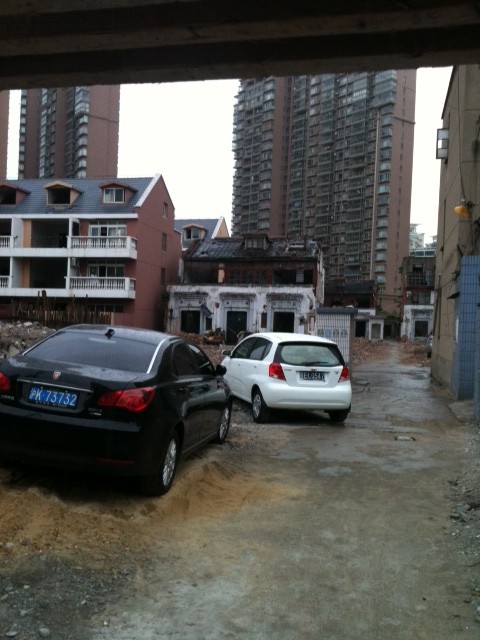
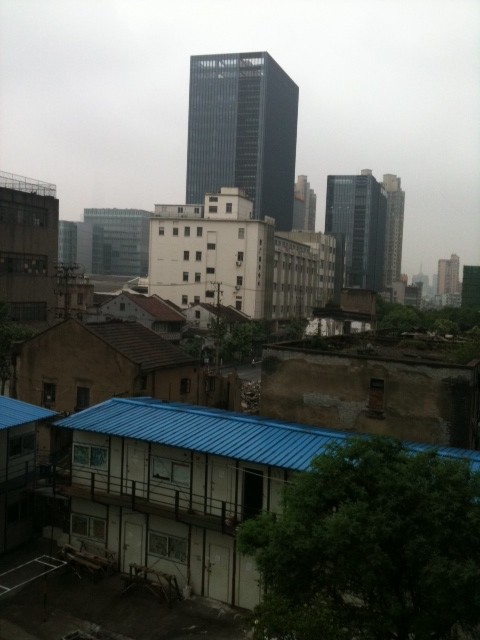
Posted: June 30th, 2011 | No Comments »
I’m back…and Lisa See is back too, so I’ll gently ease back into things by noting her follow up to Shanghai Girls – Dreams of Joy – that continues the story of the two sisters moving from Shanghai to Los Angeles. It’s selling like hot pies at the football in America. As usual publishers blurb below…

In her beloved New York Times bestsellers Snow Flower and the Secret Fan, Peony in Love, and, most recently, Shanghai Girls, Lisa See has brilliantly illuminated the potent bonds of mother love, romantic love, and love of country. Now, in DREAMS OF JOY, she returns to these timeless themes, continuing the story of sisters Pearl and May from Shanghai Girls, and Pearl’s strong-willed nineteen-year-old daughter, Joy.
Reeling from newly uncovered family secrets, and anger at her mother and aunt for keeping them from her, Joy runs away to Shanghai in early 1957 to find her birth father—the artist Z.G. Li, with whom both May and Pearl were once in love. Dazzled by him, and blinded by idealism and defiance, Joy throws herself into the New Society of Red China, heedless of the dangers in the communist regime and the Great Leap Forward.
Devastated by Joy’s flight and terrified for her safety, Pearl is determined to save her daughter, no matter the personal cost. From the crowded city to remote villages, Pearl confronts old demons and almost insurmountable challenges as she follows Joy, hoping for reconciliation. Yet even as Joy’s and Pearl’s separate journeys converge, one of the most tragic episodes in China’s history threatens their very lives.
Acclaimed for her richly drawn characters and vivid storytelling, Lisa See once again renders a family challenged by tragedy and time, yet ultimately united by the resilience of love.
Posted: June 12th, 2011 | 1 Comment »
 I’m off to London for a couple of weeks so I’m going to be strolling galleries, eating excellent food, sipping fine wines and guzzling good ales around the British Isles for a bit…and doing a bit of work unfortunately. Naturally no time to post much of anything so I’ll take a break – but fear not, back soon with both lots of old pictures, maps and China ephemera that’s sitting in the UK waiting to be collected and also, finally, all the details of my new book, Midnight in Peking, the launch and where I’ll be turning up to sell you a copy in the second half of the year.
I’m off to London for a couple of weeks so I’m going to be strolling galleries, eating excellent food, sipping fine wines and guzzling good ales around the British Isles for a bit…and doing a bit of work unfortunately. Naturally no time to post much of anything so I’ll take a break – but fear not, back soon with both lots of old pictures, maps and China ephemera that’s sitting in the UK waiting to be collected and also, finally, all the details of my new book, Midnight in Peking, the launch and where I’ll be turning up to sell you a copy in the second half of the year.
I’ll leave you with a picture reflecting a time worn rite of passage in Shanghai for this time of year, the pruning of the London planes (these over by East China Normal University), cutting back the foliage to allow for another year’s growth.
Posted: June 11th, 2011 | 3 Comments »
Later this year the excellent reprint house Earnshaw Books are reissuing EW Peters’s 1937 classic Shanghai Policeman, the true story of a sorry copper’s lot in the Shanghai Municipal Police. It’s a terrific read and full of stories from Shanghai at probably its most exciting moment in history. Additionally much of the action of the book takes place north of Suzhou (Soochow) Creek in the Hongkou (Hongkew) and Yangpu (Yangtszepoo) districts which I write about often on this blog but are still largely undiscovered by the ex-pat crowd of Shanghai who mostly stubbornly refuse to venture north of the Creek for some reason.
Earnshaw Books were kind enough to ask me to blurb the book and so I had to re-read it recently. I had completely forgotten about Peters’s vivid descriptions of the beggar-boats of Shanghai. Peters talks of the beggar-boats on the Hongkew Creek, near Kashing Road (now Jiaxing Road) and again by Fearon Road (Jiulong Road). Apparently the greatest concentration of the beggar boats was along the creek at Fearon Road between Yalu and Yuhung Roads (Haining Road East and Dongyuhang Road West), just south of the old Municipal abattoir, what is now the struggling development called 1933.
Talking of the beggar-boats in Shanghai Policeman Peters writes, ‘Numbers of these boats always infest the waterways in Shanghai at night, the beggars mooring them along the creeks in the evening, practising their profession in the streets of the city during the night, and then slipping away in these boats next morning.’ Apparently, all creeks and waterways, even in the Settlement’s boundaries, were deemed to belong to the Chinese. Hence, moving beggar boats along was problematic for the police and authorities.
I have never seen a picture of the beggar-boats of Shanghai’s creeks (and if anyone has one please do let me know). However, I wandered down to the stretch of creek on Fearon Road between Yalu and Yuhung Roads the other day – the creek is of course cleaned up and has new banks and vegetation now. The west side of the creek is all post-1949 buildings and a police station but the east side has some structures remaining that would have been there in 1937 – of course it goes without saying north of Soochow Creek that anything pre-1949 is in a state of disrepair and probably not long for this world.
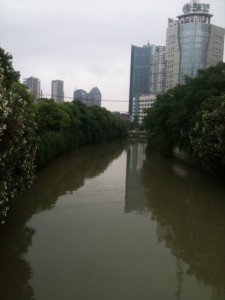 the creek facing south
the creek facing south
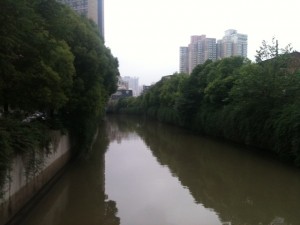 the creek facing north towards 1933, the old Municipal abattoir
the creek facing north towards 1933, the old Municipal abattoir
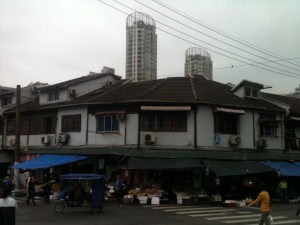 A remaining corner by the creek that would have overlooked the beggar-boats
A remaining corner by the creek that would have overlooked the beggar-boats
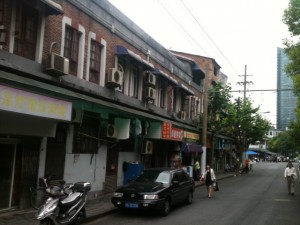 Creek side housing from the 1930s that remains
Creek side housing from the 1930s that remains
Posted: June 10th, 2011 | No Comments »
READING IN A DIGITAL AGE
Our eBook Portal is live NOW!
We are pleased to introduce the HKU Press eBookstore, where you can browse and purchase full-text HKU Press titles.  From now on, you can enhance your studies and research through access to many books previously unavailable online. You can also create personal libraries and store your own selection. Simply look for the e-book widgets on our home site to preview our ebooks.
Key Features
• 24/7 access
• Bookmarking for easy navigation
• Online and offline reading support on many e-Reader devices
• Free preview before purchase
• Full text searching across all HKU Press eBooks
• Flexible pricing and purchase plans
• Powerful quick search and browse capabilities
• Over 150 frontlist and backlist titles, and frequent update of new titles
We are very interested in your comments and suggestions on this service. Please feel free to e-mail us at upweb@hku.hk. If you would prefer not to receive occasional e-mails from Hong Kong University Press announcing our publications or events, please send a message “unsubscribe” to us at upweb@hku.hk and we will remove your name from our list. 如閣下ä¸æ¬²å†æ”¶åˆ°æœ‰é—œæœ¬ç¤¾æ›¸ç±æˆ–活動的電郵,請發 “å–消電郵訂閱” 致 upweb@hku.hk.
Hong Kong University Press 香港大å¸å‡ºç‰ˆç¤¾
The University of Hong Kong, Pokfulam, Hong Kong 香港薄扶林香港大å¸
Tel 電話: (852) 2552 4789
Posted: June 9th, 2011 | 1 Comment »
Next Friday (June 17th), the Shanghai-based street photographer Sue AnneTay (who’s work I’ve noted and rather admired here repeated times) will be speaking at the twocities Gallery (why it is a lower case ‘t’ I have no idea!) about her ongoing project “The Roving Exhibit” and about documenting street stories in Shanghai.
Date: June 17th, Friday
Time: 7:30 pm – 9pm
Location: twocities gallery åŒåŸŽçŽ°ä»£æ‰‹å·¥è‰ºæœ¯é¦†
2/F, Bldg 0, 50 Moganshan Lu, 莫干山路50å·0å·æ¥¼2楼

Sue Anne Tay, photographer and author of the popular blog, ShanghaiStreetStories.com, takes her photography back to the original sites via the use of portable photo boards in her latest project, “The Roving Exhibitâ€. Travelling across older neighborhoods such as Hongkou and Dongjiadu, Sue Anne’s exhibit engages and elicits reactions from some of Shanghai’s long-standing residents.
In a casual and intimate setting, Sue Anne will discuss with twocities her inspirations for “The Roving Exhibit”. Join us for stories from exhibit patrons and their varying impressions of street photography, the pace of urbanization and the plight of their disappearing neighborhoods.
Sue Anne’s photography has been exhibited around Shanghai and published in The Atlantic, Foreign Policy and others. She is also a co-author of “Still More Shanghai Walks: Shanghailanders & Shanghainese – Where They Lived, Worked and Played” (Old China Hand Press, 2011). Most recently, she spoke at this year’s Shanghai and Suzhou Literary Festivals.
Posted: June 9th, 2011 | No Comments »
Trolleybuses and trams used to roll through the streets of old Peking. They went the way of most of the old gates, the walls and hutongs of the city – i.e. scrapped. Now there’s a tram back in action on the Qianmen pedestrianised retail street. Though the street is failing as a commercial endeavour according to the retailers along it (either low end provincial Chinese tour groups with no money or scuzzy foreign backpackers who don’t spend either) there are lots of strollers. The tram is usually pretty empty as they charge for it and goes up and down occasionally. However, I’m not sure if its all that accurate as the sort of tram that was there before 1949. The model of tram they’re using now is different to the images I have of the old trams from the 1930s.




 Two books of mine that were published by the Hong Kong University Press included a logo design for the Press done by the Chinese artist Xu Bing (left), one of China’s foremost contemporary artists (though he lived in america for many years). His calligraphic work (which includes the HKUP logo) is excelletn with English words presented as apparent Chinese pictograms.
Two books of mine that were published by the Hong Kong University Press included a logo design for the Press done by the Chinese artist Xu Bing (left), one of China’s foremost contemporary artists (though he lived in america for many years). His calligraphic work (which includes the HKUP logo) is excelletn with English words presented as apparent Chinese pictograms.









![HKUP_eBook_Portal_[1]](http://www.chinarhyming.com/wp-content/uploads/2011/06/HKUP_eBook_Portal_1-300x288.jpg)
![PageView[1]_smaller](http://www.chinarhyming.com/wp-content/uploads/2011/06/PageView1_smaller-300x168.jpg)




